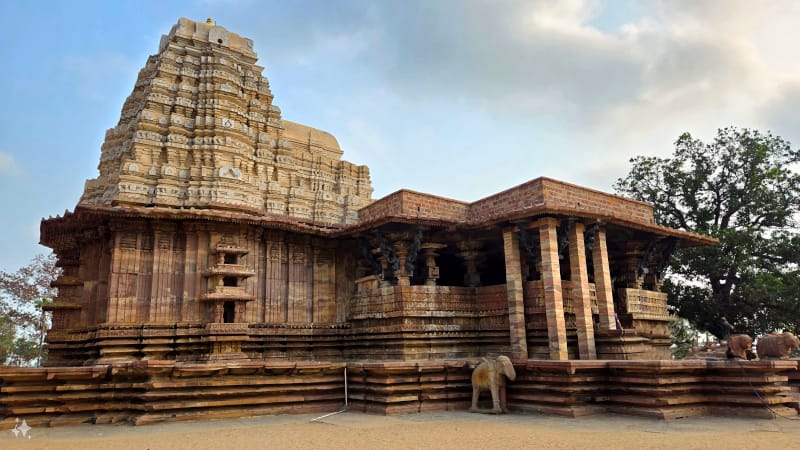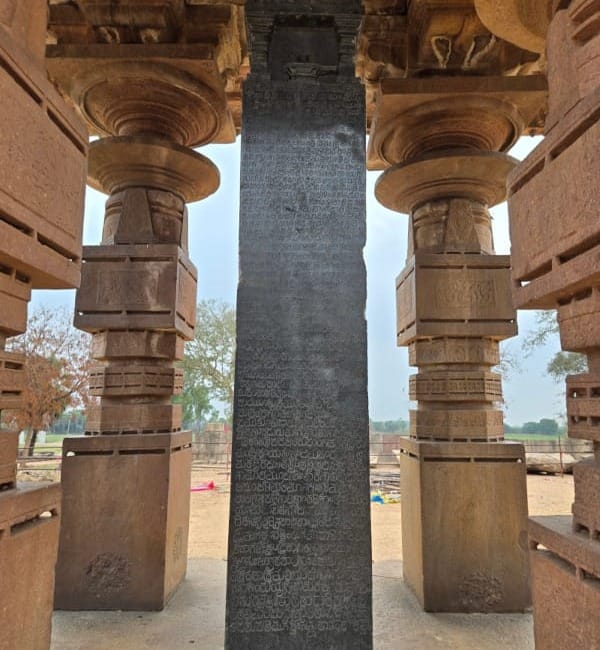Veranda Tales-Wandering in Kakatiya realms

Storytelling has been an integral part of my life since childhood. I grew up listening to stories during the hot summer evenings and nights with my cousins. Mothers and grandmothers would gather all of us children for story time. It was usually pitch dark except for a very faint light coming from the flickering candle. Power cuts were as frequent as the hot and humid summer days. We all spread out on a cool concrete floor or bamboo mats on the veranda intently listening to fascinating stories about kings, queens, princes, princesses, and peasants alike. Stories about love, life, families, and people entertained and taught us life skills. These stories transported us to distant worlds, strange yet familiar. Often the same story told by two people sounded different as storytellers added new twists and turns adding their personal style and flair to the stories.
Storytelling wasn’t limited to summer evenings and bedtime. I was surrounded by adults who didn’t pass up an opportunity to share their wisdom using the art of storytelling. These rich vibrant oral traditions include songs, poems, stories, and సామెతలు (Sametalu are proverbs in Telugu). Men and women sing songs as they work in the fields, grinding grains and spices and doing other daily chores at their homes. Stories are often used to teach important life lessons, interpersonal skills, and survival skills. These stories and the time spent listening to them made our lives richer leaving an impression on me. This series is all about reliving those memories as I share these stories.
రాజుల సొమ్ము రాళ్ళ పాలు (raajula sommu ralla paalu)
We are in awe of majestic pyramids in Egypt and Machu Picchu, temples in India and south east Asia, castles in Europe, pueblos and kivas in North America. We wonder how our human ancestors in various parts of the world built the architectural and engineering marvels without the aid of modern machines and technology. We admire the engineering skills of designers and architects who built these monuments. We stand in awe as we behold the craftsmanship, and skills of sculptors and artists who spent hours on end meticulously carving the rocks turning them into artistic masterpieces. I wish I could go back in time to be a fly on the wall to witness their miraculous feats in action.
I visited Kakatiya ruins during my pre-teen years vacationing with my family. నాన్న (Nanna is father in Telugu) took advantage of his employment benefit that paid for a family vacation every other year. He loved historic places. One such vacation took us to the Kakatiya ruins and Hyderabad. I remember traveling by bus to the city of Warangal to visit the Kakatiya temple complexes. నాన్న (Nanna) was on hand to answer my questions about the Kakatiya dynasty and its history. I read every nonfiction and fiction book about the Kakatiya dynasty I could get my hands on. I read a historical fiction novel about life in the Kakatiya dynasty. It was narrated by the main character who is a female ghost.
A man who moves to Warangal and goes to visit the Ramappa temple on a full moon night. He stumbles upon a beautiful woman sitting on a rock as the moonlight showers them both in its delicate glow. She is clothed in a shimmering white saree. She calls out to the man asking him where he was all these years. She tells him that she comes to the temple on full moon nights to wait for the love of her life. She waits all night long and leaves at dawn. She then narrates their story that took place eight centuries ago in several sessions on subsequent full moon nights. The story ends sadly when the love of her life was executed along with her for wanting to marry across the class lines. The man realizes that he was reborn many times since then, whereas the woman in front of him who was the love of his life stuck around waiting for him. I don't recall the name of this book or its author, but the narration stuck with me.
I instantly fell in love with the splendor and rich history of the Kakatiya dynasty. Four decades later, I retraced my steps with the same awe and wonder I experienced on my first visit, beholding the splendor. Just like I did on my maiden trip, I tried to imagine the glory of its bustling markets and streets, majestic temples under construction and being unveiled as I walked through the Bhadrakali temple, the Thousand pillar temple, the Kakatiya fort, and the Ramappa temple.
I wish I could go back in time to watch the miraculous feats of constructing these massive structures in action. It would be fantastic to have a front row seat to watch our ancient engineers figure out how to make floating bricks to build రామప్పా (Ramappa) temple or కాకతీయ రుద్రేశ్వర (Kakatiya Rudreshwara) temple. The temple was constructed between 1212 and 1234 during the golden era of the కాకతీయ సామ్రాజ్యం (Kakatiya dynasty 1150–1300 CE) under the rule of గణపతి దేవ (Ganapati Deva r. c. 1199 - 1262). The temple is a UNESCO World Heritage Site.
His daughter రాణి రుద్రమ దేవి (Rani Rudrama Devi) and her grandson, ప్రతాపరుద్ర (Prathaaparudra r. c. 1289–1323) followed in his footsteps reigning over the Telugu speaking lands of current day Telangana and Andhra Pradesh. I would love to get a glimpse of రాణి రుద్రమ దేవి (Rani Rudrama Devi r. c. 1262 - 1289), who ascended to the throne under the regal name, రుద్రదేవ మహారాజా (Rudra-deva Maharaja). When her father, గణపతి దేవ (Ganapati Deva) passed away, she became the monarch and the commander in chief of the Kakatiya army consisting of the palace guard, 72 nayakas and their soldiers. The administrative structure of the Kakatiya court included 72 nayakas (leaders or warrior chiefs in Telugu) who reported to the king or the queen. They oversaw tax collection in their regions and supplied warriors when the king or queen called upon them to defend the kingdom. రాణి రుద్రమ దేవి (Rani Rudrama Devi) faced revolt and opposition from some nayakas and their soldiers who felt it was beneath them to take orders from a woman. రాణి రుద్రమ దేవి (Rani Rudrama Devi) crushed the rebellion quickly.
According to an early 14th-century text, గణపతి దేవ (Ganapati Deva) recognized his daughter’s potential to be a warrior and a monarch. He raised రాణి రుద్రమ దేవి (Rani Rudrama Devi) like a son, educated her to be monarch and trained her to be a fierce warrior. He created and promoted a male persona for his daughter to rule in a patrilineal society that excluded women from political power. She dressed like a man and assumed a male male, రుద్రదేవ మహారాజా (Rudra-deva Maharaja) to bolster father’s narrative. Her husband Vira-bhadra did not participate in the administration and was mentioned only a few times in the historic records as the monarch’s husband. She heeded her father’s advice to adopt her grandson ప్రతాపరుద్ర (Prathaaparudra) and nominate him as her successor and heir to the throne.
రాణి రుద్రమ దేవి (Rani Rudrama Devi wasn't a figurehead queen and commander in chief who sat on the throne while her soldiers fought in battles. She was a fierce warrior who died on the battlefield defending her people at the age of 83. An inscription at Chandupatla dated November 27th 1289 AD, recorded her death in a battlefield a few days earlier. Her grandson, ప్రతాపరుద్ర (Prathaaparudra) ascended to the throne under the regal name, రుద్రదేవ (Rudradeva) II. He was the last ruler of the Kakatiya dynasty.
The Kakatiya dynasty promoted music, dance, sculpture, and commissioned construction of massive temples and structures. They built large చెరువులు (cheruvulu are reservoirs in Telugu) for irrigation. They built temples on the banks of these reservoirs for worship. The Ramappa Lake by the Ramappa temple, the Bhadrakali Lake by the Bhadrakali temple , the Laknavaram Lake, the Pakhal Lake, the Waddepally Lake, and the Ghanpur Lake built by గణపతి దేవ (Ganapati Deva) continue to sustain irrigation to feed people to this day. These reservoirs were built after a two year long famine in the కాకతీయ సామ్రాజ్యం (Kakatiya dynasty) during the reign of గణపతి దేవ (Ganapati Deva). Building reservoirs was important to the dynasty as their revenue depended on farmers growing crops and paying a 5th of their yield to the king.
Like her father, రాణి రుద్రమ దేవి (Rani Rudrama Devi) continued temple building and fortification of the Kakatiya fort in Orugallu (present day Warangal). You can see the remnants of the outer mud wall as you head towards the solid rock walls of the fort. She built a రంగ మండపం (ranga mandapam is dance floor in Telugu) at the Kakatiya fort in Orugallu. Oru means one and gallu means rock in Telugu. People live inside the perimeter of the mud walls and rock walls.
The Kakatiya architecture is known for its delicate carvings and detailed sculptures. They used stone, sandstone, and black granite in many of their temples and forts. The temples and structures were built to withstand earthquakes and other natural disasters using the sandboxing technique. This technique involves digging a 20 foot deep pit for laying foundation and filling it with a mixture of sand, lime, jaggery for binding, and karakkaya (black myrobalan fruit). Ramappa temple was built using the sandboxing technique and has withstood earthquakes, cyclones, and other natural disasters since its construction 800+ years ago and is still standing to this day. The Ramappa temple was built using red sandstone with generous use of polished black granite for pillars and sculptures. The polish on the black granite still shines to this day. The temple complex was named after its designer and architect, Ramappa.

An inscription in the temple records that the temple was constructed in the year 1213 CE by Recherla Rudra who was a general of Ganapati Deva.The carvings on the temple consist of decorated beams and women dancers sculpted out of black granite as brackets. The temple was built using floating bricks to reduce the weight. These bricks were made using sand mixed with seeds before kilning. The seeds burn away during the firing process leaving small holes in the brick making it light enough to float in water. The sculptures on the temple walls depict dancers in various dance poses and musicians playing their instruments.
My love for all things Kakatiya which began four decades ago is still alive. As I stood in awe in front of the Ramappa temple, the Thousand pillar temple, and the Kakatiya fort, or think about them, I remember this శిలలపై శిల్పాలు చెక్కినారు song in Telugu written by ఆచార్య ఆత్రేయ and set to music by కె.వి.మహదేవన్. Legendary Telugu singer, ఘంటసాల gave it life.
I am fascinated by their splendor and the stories these temple complexes continue to tell us about a long gone era even to this day. They remind us of the glory of the Kakatiya empire and the people who lived during that time. On the other hand, the cynic in me wonders how wasteful it was to build these massive structures. I can't help but say, “రాజుల సొమ్ము రాళ్ళ పాలు (raajula sommu raalla palu)" which means "wealth or riches of kings gets wasted on rocks". రాళ్లు (rocks) in this context could also mean precious stones, implying that kings waste their money on precious stones and jewels.
I am conflicted on this subject of whether monument building is wasteful or not. Could the money and resources be used for the betterment of people? At the same time, I recognize the advancements made in engineering, science, and building techniques because of these very projects. I acknowledge their value in providing gainful employment to sculptures, stonemasons, artists, and several others to build them.
I have fond memories from my two visits to these magnificent Kakatiya temple complexes having had the good fortune to visit them with people near and dear to me. On my second trip, I was able to share my enthusiasm and passion for all things Kakatiya with my teenage son. My son and I wandered the Kakatiya realm in awe as my బాబయ్య (babayya is father’s younger brother in Telugu) shared his rich knowledge of this area. బాబయ్య (babayya) is equally passionate about the Kakatiya dynasty. It was amusing to watch him share his rich knowledge with guides and local people. He knew about the place better than the local guides. We searched and found శాసనాలు (sasanaalu are inscriptions in Telugu) at each and every temple and at the Kakatiya fort in Warangal.

We saw Bhuvanagiri fort from a distance and learned that Golconda was originally a Kakatiya fort. I will silence the cynic in me for the time being to enjoy and cherish these memories.
